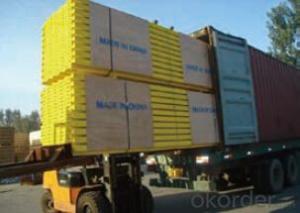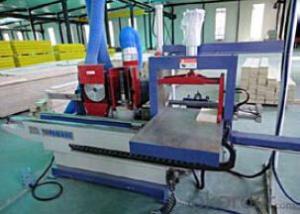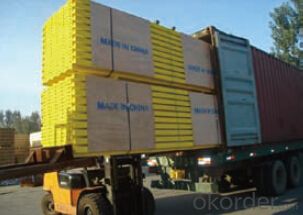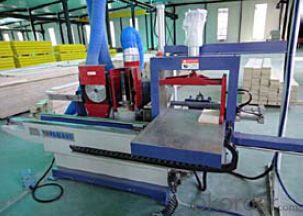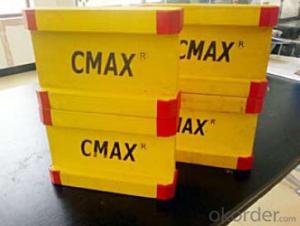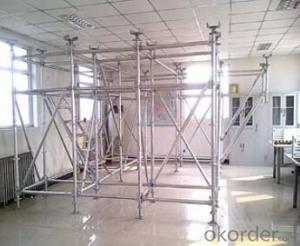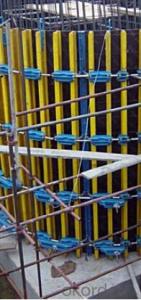Timber Beam H20 for formwork and scaffolding system
- Loading Port:
- Tianjin
- Payment Terms:
- TT OR LC
- Min Order Qty:
- 50 m²
- Supply Capability:
- 1000 m²/month
OKorder Service Pledge
OKorder Financial Service
You Might Also Like
Characteristics:
◆ Standardized production lines.
Supply capability: 3000m/day, Lmax = 6600mm.
◆ Finger jointing of the flange and web, the strength of timber beam is highly improved.
Max. shearing force failure load:40KN
◆ Well treated to prevent from water penetration or erosion, so the service life maximally extended.
Normally, CNBM timber beam H20 can be used for 4 to 5 years, the exact using time would depend on maintenance & storage.
◆ Robust caps at the end of the girders protect against damages.
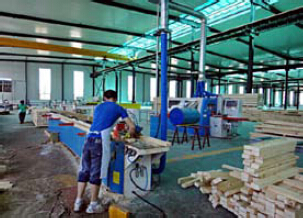
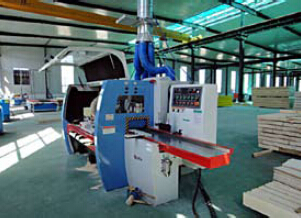

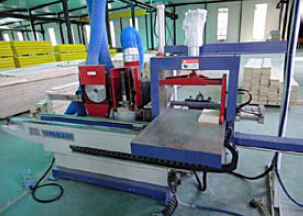
- Q: What are the considerations when selecting the size and spacing of steel formwork panels?
- When selecting the size and spacing of steel formwork panels, several considerations need to be taken into account. First, the size of the panels should be determined based on the dimensions of the concrete structure being formed. The panels should be able to accommodate the desired shape and size of the concrete element. Secondly, the spacing between the panels should be chosen to ensure adequate support and stability. The spacing should be determined based on the load-bearing capacity of the panels and the weight of the concrete being poured. It is important to have proper spacing to prevent deflection or deformation of the formwork. Additionally, the size and spacing of the panels should also consider the ease of handling and installation. Panels that are too large or heavy may be difficult to transport and assemble, leading to time and labor inefficiencies. On the other hand, panels that are too small may result in excessive joints, increasing the chances of leakage or misalignment. Overall, the selection of the size and spacing of steel formwork panels should prioritize structural integrity, functionality, and ease of use to ensure successful and efficient concrete formwork construction.
- Q: What are the different types of reinforcement used in steel formwork systems?
- There are several types of reinforcement used in steel formwork systems, each serving a specific purpose in enhancing the structural integrity and durability of the concrete structures. 1. Steel bars: Steel bars, also known as rebars, are commonly used in steel formwork systems to provide tensile strength to the concrete. These bars are placed in the formwork before pouring the concrete, and they help prevent cracking and ensure the stability of the structure. 2. Wire mesh: Wire mesh reinforcement is another commonly used type in steel formwork systems. It consists of a grid of interconnected steel wires that are welded or woven together. Wire mesh reinforcement helps in distributing the loads evenly across the concrete, improving its strength and reducing the risk of cracking. 3. Steel fibers: Steel fibers are small, discrete reinforcing elements that are often added to the concrete mix itself. These fibers enhance the tensile strength of the concrete, making it more resistant to cracking and improving its overall durability. Steel fibers are particularly useful in applications where traditional reinforcement may be difficult to install. 4. Stirrups and ties: Stirrups and ties are commonly used in reinforced concrete structures and are also incorporated into steel formwork systems. They are typically made of steel bars and are used to hold the main reinforcement bars in place and provide additional support to the structure. Stirrups and ties help prevent the rebars from shifting or bending during concrete placement and ensure proper alignment and spacing. 5. Steel plates and brackets: Steel plates and brackets are used in formwork systems to provide additional support and stability to the structure. They are typically attached to the formwork panels and act as reinforcement elements, helping distribute the loads and preventing deformation or failure. Overall, the different types of reinforcement used in steel formwork systems are essential in ensuring the strength, stability, and longevity of concrete structures. They work together to resist external forces, prevent cracking, and enhance the overall performance of the structure.
- Q: Plastic building templates where there is an urgent need to solve
- Plastic construction formwork turnover number can reach more than 30 times, but also recycling. The temperature range is large, the specification is strong, can be seen, drill, easy to use. The smoothness and smoothness of the surface of the template exceed the technical requirements of the existing clear water concrete formwork, and the utility model has the functions of fire resistance, corrosion resistance, water resistance and chemical corrosion resistance. Can meet the demands of building formwork of various cuboids and cubes, L shape, U shape requirements.
- Q: How does steel formwork affect the overall flexibility of the structure?
- Steel formwork can significantly affect the overall flexibility of a structure in a positive way. Unlike traditional timber formwork, steel formwork is known for its strength, durability, and rigidity. These qualities allow for the construction of more robust and stable structures. The use of steel formwork provides enhanced flexibility in terms of design and construction. Steel formwork systems are highly adaptable and can be easily adjusted and modified to suit different project requirements. This flexibility allows for the creation of complex shapes and structures, such as curved walls, without compromising the overall strength and stability. Furthermore, steel formwork offers a higher load-bearing capacity compared to other formwork materials. This increased strength allows for the construction of taller and more expansive structures. The rigidity of steel formwork also minimizes deflection and deformation, ensuring the structural integrity of the building. Moreover, steel formwork is known for its reusability. Unlike other formwork materials, steel formwork can be used multiple times, making it a cost-effective solution. This reusability factor also contributes to the overall flexibility of the structure as it allows for easy dismantling and reassembly, facilitating any required modifications or renovations in the future. In conclusion, steel formwork significantly enhances the overall flexibility of a structure due to its strength, durability, and adaptability. Its ability to handle complex designs, higher loads, and its reusability make it an ideal choice in construction projects, providing a solid foundation for creating flexible and resilient structures.
- Q: What are the cost implications of using steel formwork?
- The cost implications of using steel formwork can vary depending on several factors. Initially, the upfront cost of steel formwork may be higher compared to other alternatives like timber or plastic. However, steel formwork offers higher durability and longevity, reducing the need for frequent replacements or repairs. This can result in long-term cost savings as steel formwork is more resistant to wear and tear. Additionally, steel formwork allows for faster construction cycles due to its sturdiness and ease of use, potentially reducing labor costs. Overall, while the initial investment may be higher, the long-term benefits and reduced maintenance expenses make steel formwork a cost-effective choice in many construction projects.
- Q: How does steel formwork handle different concrete segregation tendencies?
- Steel formwork is highly effective in handling different concrete segregation tendencies due to its strength and durability. It provides a rigid structure that minimizes the risk of concrete segregation during the pouring and curing process. The smooth surface of steel formwork prevents the accumulation of excess water or aggregates, reducing the chances of segregation. Additionally, steel formwork can be easily adjusted and reinforced to accommodate varying concrete placement methods, ensuring uniform distribution and minimizing the potential for segregation.
- Q: What are the common safety certifications for steel formwork?
- Construction projects utilize various safety certifications to ensure the compliance of steel formwork with specific safety regulations and standards. The OSHA certification, widely recognized for its Occupational Safety and Health Administration, guarantees that the steel formwork adheres to OSHA's safety regulations. This certification encompasses elements like stability, load-bearing capacity, and structural integrity. Another reputable certification is provided by the American National Standards Institute (ANSI), which establishes standards for construction equipment and materials, including steel formwork. This certification assures that the formwork meets essential safety requirements, such as strength, durability, and stability. In Europe, the EN 12812 standard is crucial for certifying steel formwork. It outlines the requirements for formwork systems and confirms their safety and performance. The certification assesses aspects like load-bearing capacity, stability, and safety factors. Additionally, the International Organization for Standardization (ISO) offers certifications related to steel formwork safety. The ISO 9001 certification ensures that the manufacturer possesses a quality management system, while the ISO 45001 certification focuses on occupational health and safety management systems. Depending on the country or region, additional specific certifications may be necessary. For instance, the British Standards Institution (BSI) certification may be required in the United Kingdom. Overall, these safety certifications for steel formwork provide construction professionals with confidence that the formwork they employ meets the requisite safety standards and regulations. It is crucial to ensure that certified steel formwork is utilized on construction sites to prevent accidents, prioritize worker safety, and maintain the structural integrity of the formwork.
- Q: How does steel formwork handle different concrete surface treatments?
- Steel formwork is highly versatile and can handle different concrete surface treatments effectively. The smooth and rigid nature of steel formwork allows for the application of various surface treatments, such as textured finishes, exposed aggregate, or decorative patterns, without compromising the quality or integrity of the concrete. Steel formwork provides a stable and durable framework that ensures the desired surface treatment remains intact during the concrete pouring and curing process. Furthermore, the reusability of steel formwork allows for consistent and reliable results across multiple projects with different concrete surface treatments.
- Q: How does steel formwork affect the overall thermal insulation of a building?
- Steel formwork has no direct impact on the overall thermal insulation of a building. Its purpose is to provide structural support while the concrete is poured and shaped. It is a temporary structure that is taken down once the concrete has hardened. The thermal insulation of a building is primarily determined by the materials used in the walls, roof, and floors, as well as the design and installation of insulation systems. These materials and systems are separate from the steel formwork used during construction. However, it is important to note that the use of steel formwork may indirectly affect the thermal insulation of a building. The construction process itself, including the use of formwork, can influence the quality of the insulation installation. If not managed properly, the installation of insulation materials during or after the removal of steel formwork may be compromised, resulting in gaps, voids, or inadequate installation that can impact thermal insulation. Therefore, it is crucial to ensure that proper construction practices are followed, and insulation materials are correctly installed after the removal of steel formwork. This will help maintain the desired thermal insulation performance of the building.
- Q: How does steel formwork compare to plastic formwork in terms of cost and durability?
- Steel formwork is generally more expensive than plastic formwork in terms of upfront cost. The cost of steel formwork includes the cost of material, fabrication, and transportation, which can be higher compared to plastic formwork. On the other hand, plastic formwork is relatively cheaper due to its lower material and production costs. However, when it comes to durability, steel formwork has a significant advantage. Steel is known for its strength and durability, making it capable of withstanding heavy loads and repeated use over time. It is resistant to wear and tear, deformation, and damage caused by external factors such as weather conditions or mishandling. This durability ensures that steel formwork can be reused multiple times, resulting in cost savings in the long run. Plastic formwork, while cost-effective initially, may have limitations in terms of durability. Plastic is not as strong as steel and may be prone to deformation or cracking, especially under heavy loads or if not handled properly. Although plastic formwork can still be reused multiple times, it may require more frequent replacement or repair compared to steel formwork. In summary, steel formwork may be more expensive initially but offers superior durability and longevity. Plastic formwork, on the other hand, is cheaper but may not withstand heavy loads or repeated use as effectively as steel. The choice between the two depends on the specific project requirements, budget constraints, and the expected lifespan of the formwork.
Send your message to us
Timber Beam H20 for formwork and scaffolding system
- Loading Port:
- Tianjin
- Payment Terms:
- TT OR LC
- Min Order Qty:
- 50 m²
- Supply Capability:
- 1000 m²/month
OKorder Service Pledge
OKorder Financial Service
Similar products
Hot products
Hot Searches
Related keywords
